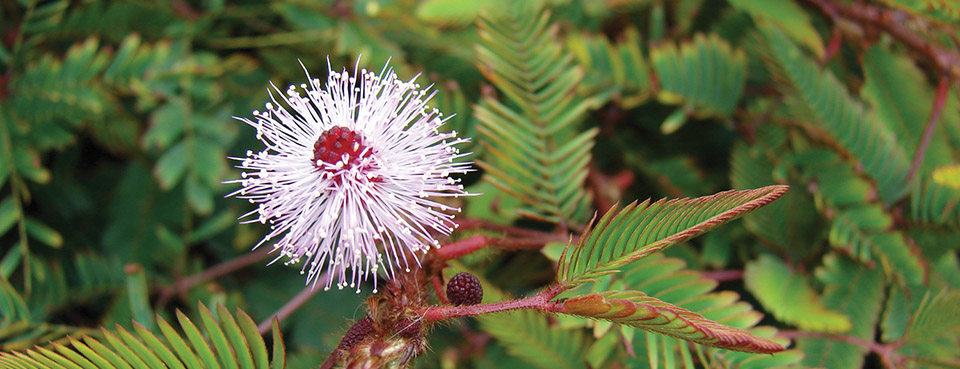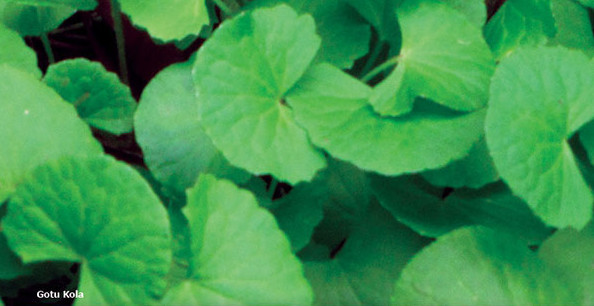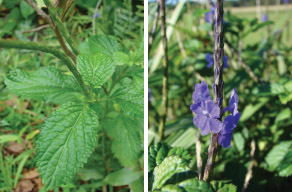
Healing Plants – Mimosa Pudica: Bothersome Weed has Redeeming Qualities
 Invasiveness Designation: PIER (the Pacific Island Ecosystems at Risk project) has assessed mimosa as invasive and recommends that it not be imported into Hawai‘i and other Pacific Island countries from its native locales.
Invasiveness Designation: PIER (the Pacific Island Ecosystems at Risk project) has assessed mimosa as invasive and recommends that it not be imported into Hawai‘i and other Pacific Island countries from its native locales.
By Barbara Fahs
A small, prickly weed we all love to hate is full of surprises. You know it as “sleeping grass,” “shy grass,” or “sensitive plant,” and it seems to grow everywhere. The surprise is that it has medicinal properties that can help to calm the nerves and promote restful sleep.
Its botanical name is Mimosa pudica, although it goes by many names, such as pua hilahila in Hawaiian, “tickle me plant,” and “bashful plant” in some places because when you touch the leaves they fold up, which some people find amusing. The names pudica and hilahila both translate to “ashamed” or “bashful.”
Identification and Origin

If you don’t know what this little plant looks like, consider yourself lucky! It’s the scourge of many gardeners in Hawai‘i, and those who want to keep their gardens tidy struggle with keeping it weeded out.
Mimosa is a creeping annual or perennial herb with fern-like leaves and puffy purple flowers that form legume-like seedpods. Stickers on the stems are a distinguishing feature, so wear gloves when harvesting and working with it. If you wanted to propagate it, it does well from seed or cuttings. You might be asking yourself, “Why on earth would I want more of this pest?” When you learn the medicinal uses, you might change your tune.
Botanists believe mimosa originated in Brazil. It is a common weed in many tropical areas such as Hawai‘i, throughout the Pacific, India, Indonesia, Southeast Asia, China, and North and South America.
Medicinal Properties
The Physician’s Desk Reference for Herbal Medicines lists Mimosa’s medicinal properties as an antibacterial agent, an antibiotic, anti-inflammatory, antimicrobial, nervine, diuretic, emetic, expectorant, and sedative.
In traditional Chinese medicine, its energetic functions are said to dispel pain and relieve swelling. No scientific studies have been conducted to date that substantiate this information. Also, it is suspected that the plant might contain toxins, although it is unclear what they might be.
NOTE: The use of herbal products should not be taken lightly. Consult a physician before using any herb, especially if you are pregnant or are taking any prescribed medications, due to drug interactions.
Recipe For a Sleep Aid
In her book, Rainforest Home Remedies, Rosita Arvigo states that the Maya of Belize prepare mimosa as a sleep aid by toasting the leaves and stems, reducing them to a powder by passing the mixture through a sieve, then sprinkling the powder over the last meal of the day. Some people smoke the powdered leaves.
Fresh Mimosa Tea
Gather 10 fresh sprigs of mimosa about six inches long, and then chop them into one-inch pieces. You can include the flowers and seeds if there are any. Place your plant material in a teapot, cover with boiling water, and then let it steep for 10 minutes. Strain and drink it hot or chilled. Drink one cup of the tea before bedtime or at any other time that your nerves are on edge and you want to relax.
Mimosa Tincture
Tinctures are herbal extracts that combine plant materials with a liquid medium (vegetable glycerin or alcohol such as vodka or brandy). They are convenient to take and last forever without refrigeration. You can make a large quantity, such as a pint or a quart, and later transfer the finished tincture into one or two-ounce, easier to handle dropper-top bottles.
- Chop the aerial portions of fresh mimosa plants into one-half to one-inch pieces. It’s fine to include any flowers or stems.
- Fill a jar one third full with the chopped mimosa plants.
- Fill the jar with the liquid of your choice, shake it up, label it, and keep it in a cool, dark spot for one month.
- Shake the jar once a day.
- Strain it and take it by the dropperful as needed.
As a sleep aid, combine three full droppers with juice of any kind and take about one hour before bedtime. ❖
Picture courtesy of Forest and Kim Starr.
Contact writer Barbara Fahs: hiiakas@lava.net.
More Info:
- Medicine At Your Feet, David Bruce Leonard, 2012
- Hear.org/pier
- Fs.fed.us/global/iitf/pdf/shrubs/Mimosa%20pudica.pdf
- Bio.miami.edu/mimosa/mimosa.html


